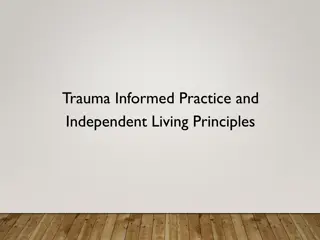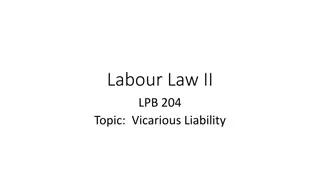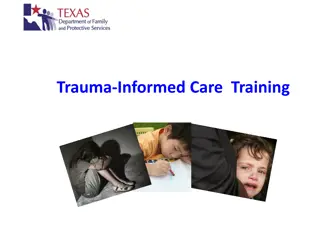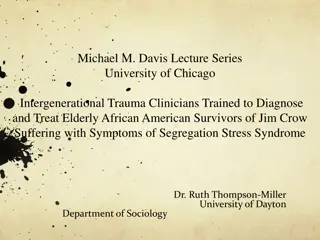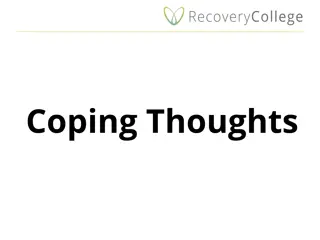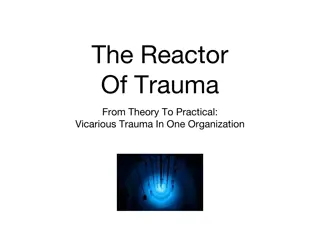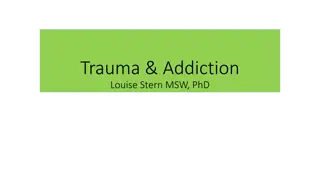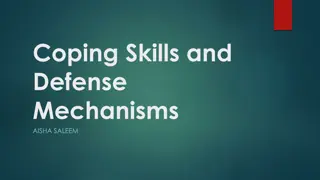Understanding Vicarious Trauma: The Impact and Coping Strategies
Vicarious trauma involves indirect exposure to traumatic experiences through listening to others' stories or viewing disturbing content, leading to changes in beliefs and emotional well-being. While it can result in positive growth, it also carries risks of compassion fatigue and burnout. Managing exposure, setting boundaries, and seeking support are crucial in mitigating the negative effects of vicarious trauma.
Download Presentation

Please find below an Image/Link to download the presentation.
The content on the website is provided AS IS for your information and personal use only. It may not be sold, licensed, or shared on other websites without obtaining consent from the author. Download presentation by click this link. If you encounter any issues during the download, it is possible that the publisher has removed the file from their server.
E N D
Presentation Transcript
Vicarious trauma: The good, the bad and what to do about it Facilitator: Melissa Harries
Understanding Vicarious Trauma Indirect exposure to trauma through People describing the trauma to you Pictures and videos of the trauma Reports/statements of the trauma Empathically engaging with a traumatised person VT is an occupational hazard. It s not a sign of weakness/character flaw. The biggest risk factor is volume of exposure Changes to fundamental beliefs about the world, self and others. Safety Trust
The Good: Post-traumatic growth/ Vicarious resilience Greater perspective and appreciation of own problems More optimistic, motivated, efficacious, and reenergized Increased sense of hope, understanding, and belief in the possibility of recovery from trauma and other serious challenges Profound sense of commitment to, and finding meaning from the work Discussion: What are some of the ways that trauma exposure in your career has had a positive impact?
The bad The expectation that we can be immersed in suffering and loss daily and not be touched by it is as unrealistic as expecting to be able to walk through water without getting wet. (Remen, 2006) Compassion fatigue a reduced empathic capacity Burnout exhaustion, cynicism, and diminished efficacy/confidence in ability to do the job Secondary traumatic stress (similar to PTSD) Intrusive thoughts Avoidance Physiological activation
What can make VT stickier? Similarities between your life and the trauma Similarities between your life and the trauma E.g. Victim was 3 year old boy and you have 3 year old boy. You have been through a similar trauma Your revs are up because of: Your revs are up because of: Other life stress Too much work, not enough rest/recovery The number or severity of other trauma Not enough social support (team, leaders, friends, family) Overusing avoidance to cope e.g. drink too much, never talk about it
Managing exposure First rule of trauma limit exposure where ever possible Who needs to see/look/hear? Restrict non-essential access Who can overhear? Limit time on task Deliberately engage with traumatic content Earlier is better Psychologically decide to engage Manage heart rate Schedule your wellbeing around it Consider your threshold What is your capacity for this type of trauma? Address known similarities E.g. Victim was 3 year old boy and you have 3 year old boy.
Peer to peer debriefing End of day debrief 10 15 mins (otherwise wont move it from working into stored memory) can be group, pairs, self, verbal or written o What has happened at work that has impacted me today? (trigger) o How has this impacted me? (symptom) o What do I need to do to take care of this today? (coping)
What helps social wellbeing Talking about your experience with someone you trust (including labeling how you feel) Supervision or proactive mental health support (for the same reason you get your car serviced regularly) Positive social connections Supportive leaders and colleagues Score out of 10?
What helps physical wellbeing High quality diet Regular exercise Not too much alcohol Looking after your sleep Seeing your GP/specialist Score out of 10?
What helps emotional wellbeing Activities that are restful, relaxing or restorative Doing things that are important, meaningful Doing things that are fun, interesting, distraction Mindfulness or being aware of thoughts, feelings and reactions (not judging them) Score out of 10?
Wellbeing review in pairs What ONE area can you improve? What would it take to move you one point up (e.g. from 4 to a 5)? Physical Social How will you do that in the next 2 weeks? Review: Is the action specific, measurable and realistic? Emotional
Sources of mental health support Legal Aid EAP 6 sessions per year On site EAP at metro offices Critical Incident debriefing on request VT Champions MHFA eLearning course on Managing the risk of VT





